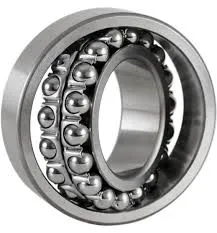
Nov . 08, 2024 06:31 Back to list
Thrust Ball Bearings Comprehensive Guide for Performance and Selection
Understanding Thrust Ball Bearings A Comprehensive Overview
Thrust ball bearings play a crucial role in machinery and equipment, providing support for axial loads while allowing for minimal friction and enhanced performance. This article explores the fundamental principles, applications, and advantages of thrust ball bearings, drawing on insights from industry catalogs.
What are Thrust Ball Bearings?
Thrust ball bearings consist of two grooved rings (the races) and a ball placed between them. Unlike radial ball bearings that handle radial loads, thrust ball bearings are specifically designed to support axial loads, which are loads parallel to the axis of rotation. This unique design enables them to operate in applications where load direction is primarily vertical or horizontal, ensuring stability and reliability.
Key Characteristics
1. Load Capacity Thrust ball bearings are engineered to manage high axial loads. Their design allows them to handle loads from both directions, making them ideal for applications where the direction of load can change.
2. Material and Design Typically made from high-quality steel, these bearings exhibit durability and resistance to wear. Some variations include ceramic materials for enhanced performance in extreme conditions, such as high temperatures or corrosive environments.
3. Sizes and Configurations Thrust ball bearings are available in various sizes and configurations to meet specific application needs. Standard dimensions ensure compatibility with a wide range of machinery.
Applications of Thrust Ball Bearings
Thrust ball bearings are utilized across various industries, showcasing their versatility. Some common applications include
thrust ball bearing catalog

- Automotive Industry In vehicles, thrust ball bearings support components like clutches and gear mechanisms. They ensure smooth operation and efficient load management during acceleration and deceleration.
- Aerospace Sector These bearings are crucial in engines and landing gear assemblies, where reliability and performance are mandated. Their ability to withstand harsh operating conditions makes them indispensable in aviation technology.
- Industrial Machinery Thrust ball bearings are integrated into conveyor systems, hydraulic systems, and pumps. They facilitate smooth operations while accommodating thrust loads that arise from these dynamic systems.
Advantages of Thrust Ball Bearings
1. Reduced Friction The smooth movement of the balls within the races minimizes friction, leading to decreased energy consumption and improved efficiency in machinery.
2. Longevity Due to their robust construction and quality materials, thrust ball bearings have a long service life. Regular maintenance can further extend their operational lifespan.
3. Easy Installation Thrust ball bearings are designed for straightforward installation and replacement, reducing downtime during maintenance and repairs.
Conclusion
Thrust ball bearings are integral components in modern machinery, providing essential support for axial loads in diverse applications. Their design and functionality not only enhance the efficiency and longevity of equipment but also contribute to the overall safety and reliability of industrial and automotive operations. Understanding the specifications and applications of these bearings, as outlined in industry catalogs, empowers engineers and technicians to make informed decisions tailored to their specific needs. As technology continues to evolve, the importance and advancements in thrust ball bearings will remain pivotal in driving innovation within various sectors.
Latest news
-
Premium Deep Groove Ball Bearings | High Speed & Reliability
NewsAug.29,2025
-
Durable Scaffolding Clamps - Secure & Reliable Tube Connectors
NewsAug.28,2025
-
Common Failures in Thrust Ball Bearings and Solutions
NewsAug.22,2025
-
How Tapered Roller Bearings Can Take Shock Loads
NewsAug.22,2025
-
Angular Bearings in High-Precision Spindles
NewsAug.22,2025
-
The Impact of Misalignment on Cylindrical Roller Bearing Performance
NewsAug.22,2025
